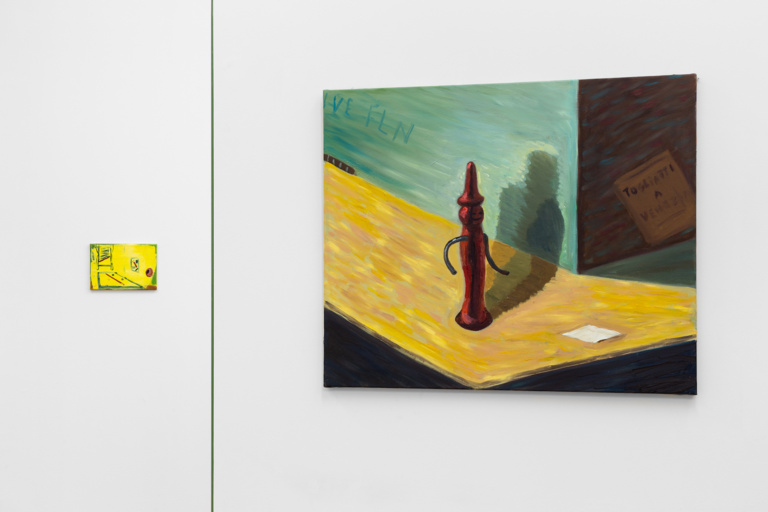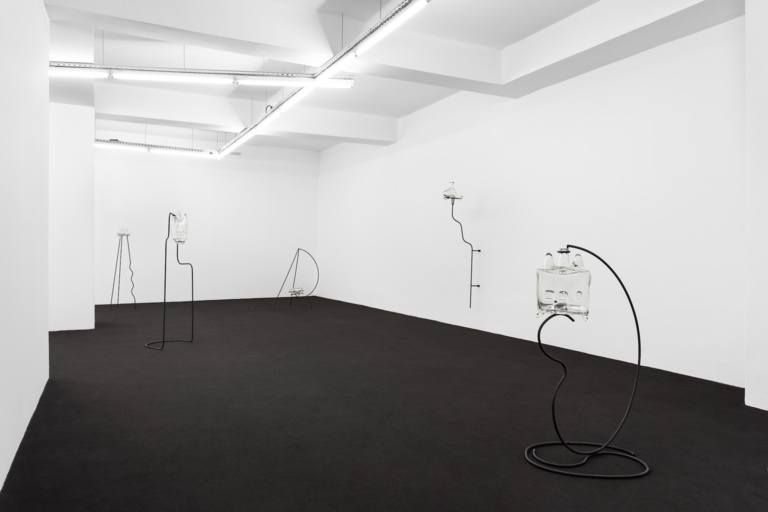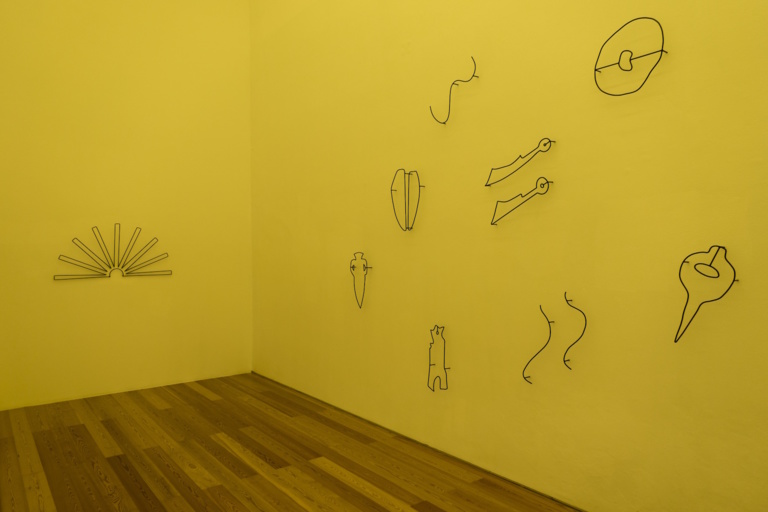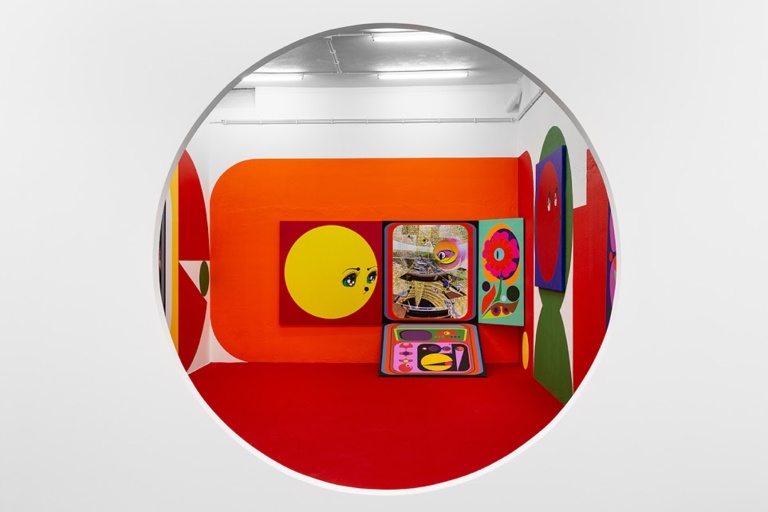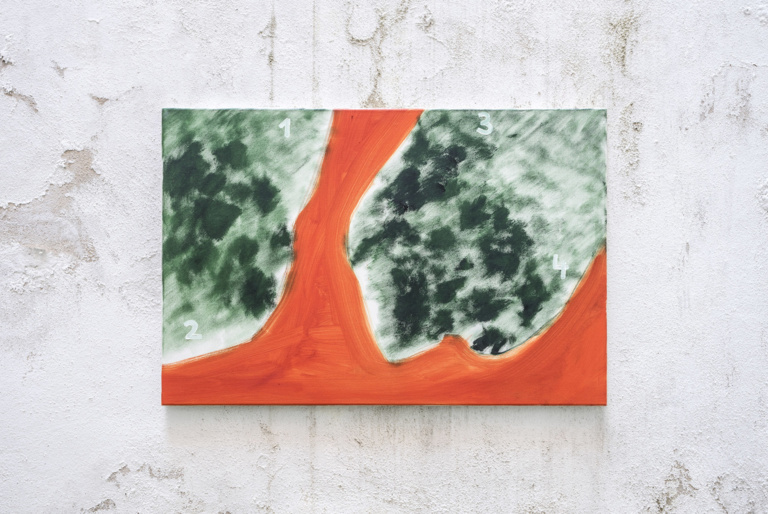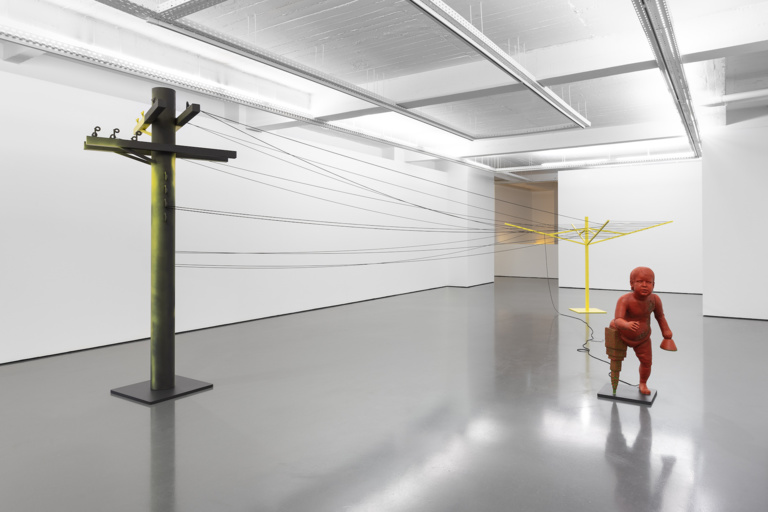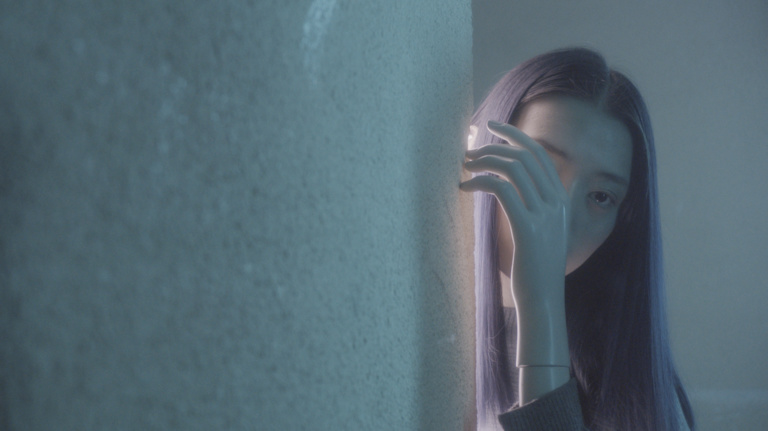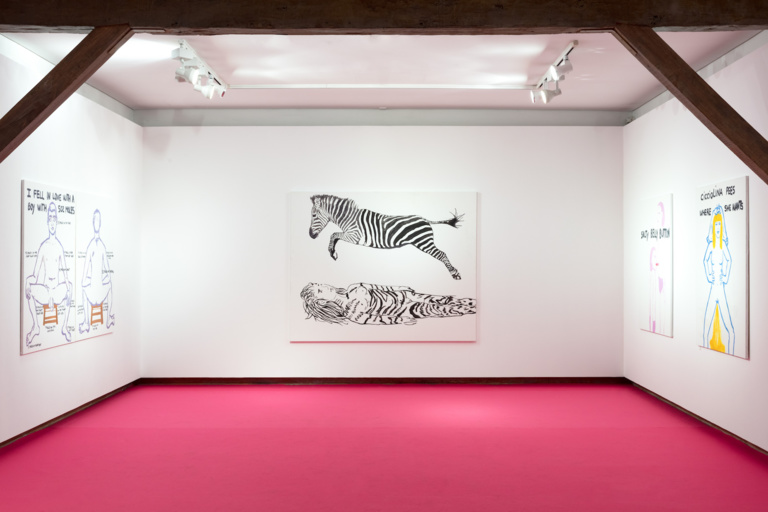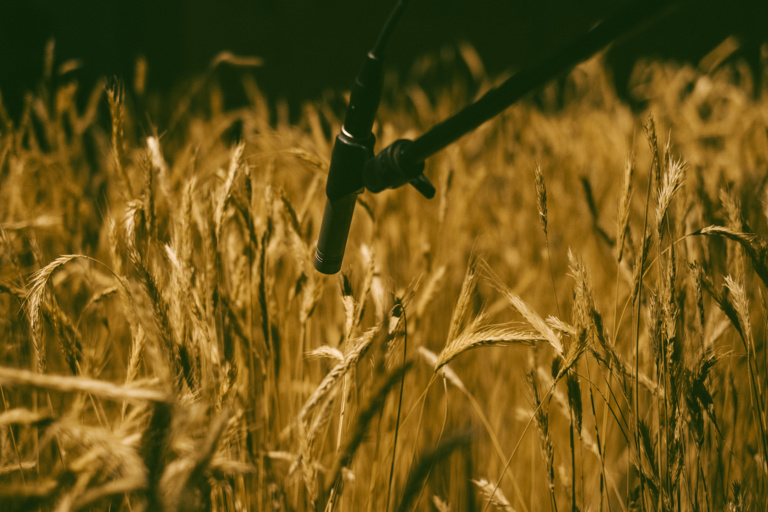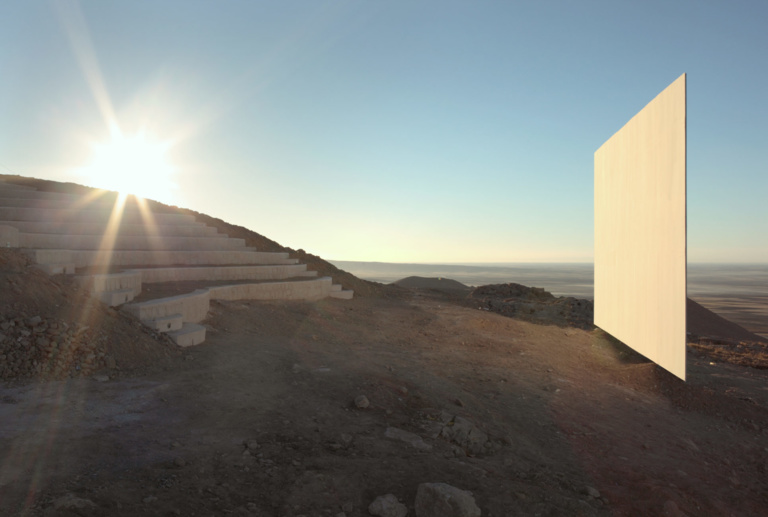Review — by José Marmeleira
In an exhibition curated by João Maria Gusmão and Natxo Checa at Galeria Zé dos Bois, Gonçalo Pena reveals to us the state in which his painting stands. That is, the state of his relationship with painting and with what is external to it: history, namely that of the 20th century, of the other arts, of the moving image, of the conditions of modernity. The art of Gonçalo Pena has long stood in a constant becoming. Although the same could be said about other artists, this one is a convulsive, exposed becoming. Exhibition after exhibition, it keeps on losing covering, facing crises, experiencing moments of iconoclasm and iconodulism. It is meta-painting and painting poring over the world.
Review — by Sérgio Fazenda Rodrigues
Fernanda Fragateiro's exhibition at Galeria Filomena Soares reveals a set of medium- and large-sized sculptures arranged in the venue's main room. Using as title the sentence "Monotony is Nice," stated by Charlotte Posenenske regarding the uniformity of a flat landscape, the exhibition relies upon the research Fragateiro has been developing on the work of several women artists and on how the latter have reacted against the art, political, and social system they have come from.
Review — by Susana Ventura
Each of Andreia Santana's works renders us surprised at the boundaries they have set out to cross. Any designation or summary idea is hard to arrive at, beyond the unceasing enquiry into the very domain of sculpture and the recognition of certain stylistic traits among her works as well as traces of a continuous thinking both on artistic practice, its display, its classification, and its conservation (themes that cut across her work and are taken into new consideration in this exhibition).
Review — by Miguel Mesquita
Diana Policarpo belongs to a category of artists that, beyond a technical and conceptual enquiry into the means of artistic production and reproduction, brings into the creative space a critical, complex, interrelational thinking that takes the anthropocene condition into consideration—in Policarpo's case, by analysing the causes and consequences of anthropogenic transformations in concomitance with the inevitable repercussions of civilisational development. This approach entails a skilful, oft-difficult, very fragile management of both the enquiry and the communication processes of the formal results proceeding from this position.
Interview — by Isabel Carlos
Although the aspects of modernism, of architecture, of the African have been rather prominent throughout my career, the truth is a negotiation among forms, images, compositions has always been present. There's a lot happening at the same time, and now I feel comfortable fetching threads from a skein that can and should be explored, which for various reasons haven't flourished so far; and though they have remained numb for 25–30 years, they're mine, and they're very real. Therefore, I feel I'm in a good position to retrieve them, to rehabilitate them, to take them up again.
Interview — by Eduarda Neves
Developing an artistic practice that cuts across different media and disciplines, Tiago Madaleno presents his latest exhibition at RAMPA, in Porto. This project was supported by the Porto City Council art creation programme Criatório 2019. In conjunction with the exhibition, a book of the same title has been published, comprising texts by Allen S. Weiss and Pedro Pousada, as well as a conversation between Madaleno and Nancy Perloff. Tiago Madaleno has been exhibiting since 2013, and was awarded the Novo Banco Revelação prize in 2017 with the work Clepsydra.
Review — by José Marmeleira
Questioning models and categories is a rather usual, dear exercise for many artists, especially after the advent of modernity. It just so happens that its focus has shifted. Models and categories are increasingly external to the domain of art: not only are they strictly social or political, they are also sexual and biological. In other words, art, or at least a significant part of it, without ceasing to observe itself, has been observing what it means to be human.
Essay — by Filipa Correia de Sousa
Very seldom do we nowadays have the chance to see paintings on a non-white wall, indeed. That is, a wall of a purportedly neutral background, one unpolluted by particularities and sterile in its white and clear appearance. As we know, painting might request, or even demand, such a white surface because of the freedom and flexibility the latter provides to the arrangement and installation of the former, as well as to the clarity that proceeds from the play of light and reflections established in the space where the painting is presented and, ultimately, gazed at by viewers.
Interview — by David Silva Revés
"Sage comme une image" is Horácio Frutuoso's latest exhibition at the Balcony (Lisbon), the gallery that represents him. Open until 18 November, this exhibition set the theme for a (Zoom) conversation with Horácio that not only approached subjects directly related to it but also comprised considerations on art, the image, the art system, and the figure of the artist; thoughts on life and the contemporary world; concerns surrounding death…
Article — by Alberta Romano
"It’s a date" is a new column of Contemporânea written by Alberta Romano and dedicated to studio visits with artists from Lisbon and from all over the word, both in person and online. Episode 1: Fernão Cruz. I ring the bell outside Fernão’s studio. I can already take a peek at some of his paintings through the glass window. Then I see him coming up from the staircase, he puts on his mask and opens the door. The date has started. Fernão's studio (which he shares with Horácio Frutuoso) extends over two floors: a shop window at street level works as the main entrance and display area for some of his pieces, but it is in the more spacious
underground room that he has the majority of his works.
Review — by Cristina Sanchez-Kozyreva
Belen Uriel’s sculptures are puzzling constructions. Made from organic materials such as paper pulp, glass, and bronze, the Madrid-born artist crafts awkward fragmented replicas of daily objects—such as baskets, small inflatable mattresses, or backpacks that bear the various marks of human interaction. The shapes she creates retain some of the characteristics of the original models, but they are also greatly transformed by her hands during their making. “They are very basic objects of consumption to start with. I don’t have that much imagination,” smiles Uriel. “I use things that exist and that we use in society. Then the transformation step is very important for me”, she explains about her process.
Review — by José Marmeleira
One might say Nuno Sousa Vieira's Deep Line, curated by Sérgio Fazenda Rodrigues, is an exhibition that unprecedentedly expands the artist's conceptual and aesthetic topoi. In other words, it renders visible and thinkable the multitudinous subjects Nuno Sousa Vieira has reflected upon throughout his career. Namely, the significance of vision in the depiction of the world, the perception of the object of art, the senses triggered by intervention on objects and space, the dialectic between the mundane and the abstract. The tensions, correspondences, convergences, parallels, paradoxes raised are at the centre of the experience the visitor is offered at Fundação Carmona e Costa. An experience which requests, or requires, a knowledg
Essay — by Filipa Correia de Sousa
Joana Fervença's exhibition yes, unless—the second exhibition of Ana Cristina Cachola's curatorial project quéréla[4]—is fulfilled in two different moments that contaminate one another. The room is dark, punctuated by two spotlights and pulsating echoes that resounds near the place occupied by the viewer in the foyer. Projected on a suspended, large, white screen, the image of a drawing; and, because Joana Fervença's works, considering their meticulous quality, invite the viewer to come closer.
Article — by Alberta Romano
It’s a date is a new column of Contemporânea written by Alberta Romano dedicated to studio visits with artists from Lisbon and from all over the word, both in person and online.studio visits with artists from Lisbon and from all over the word, both in person and online. Episode N2: Dana Lok. Lisboa > Brooklyn. I recently understood (or at least I presume I did) the difference between MY time and the time that the rest of the world seems to “impose” on me.
Review — by Cristina Sanchez-Kozyreva
The night of October 31st is Halloween, the eve of the Christian festival of all saints All Saints' Day. But it is also São Paulo-based artist Yuli Yamagata’s birthday. For her first exhibition with Madragoa in Lisbon, called BRUXA (“Witch”, until October 31), Yamagata floods the gallery with dramatic characters and witchy props like an explosion of candies. The notion of witchcraft is often treated as children’s beliefs or cultural ideology. For the latter, it can be a means to describe life’s adversities by attributing them to occult beings or people who are unwelcomed in a particular community (notably, in the case of witches, women were historically targeted)
Review — by Cristina Sanchez-Kozyreva
In his Interpretation of Dreams, published in 1899, Sigmund Freud proposes that studying dreams offers an effective tool for unpacking the unconscious activities of the mind. He suggests writing down all that we can remember, without instant-judgement, but relying on a natural, creative human penchant for associative ideas and descriptions. In doing so, we are able to reveal even the oddest fragments of narratives. In fact, the dreamer herself is the only one who can approximate an interpretation. Nothing is linear with dreams, their elucidation being as personal as the dream itself.
Review — by Susana Ventura
"Come to Dust" is Karlos Gil's second solo exhibition at Galeria Francisco Fino, in Lisbon, three years after Phantom Limbs, whose trace we still recognise in a floor sculpture in synthetic polymer titled Phantom Limbs (Body). The modules of the latter allow for different arrangements in space, and the various depressions on them resemble prothesis moulds—perhaps those that come alive before us in the exhibition's central piece, the video Uncanny Valley, which delimits two very distinct spaces within the gallery.
Review — by David Silva Revés
Are we really ducks that want to be horses? On the one hand, asking this question, or making such an assertion, would promptly entail the presupposition of a dissymmetric classification between these two beings. To the detriment of the duck, it would occupy a lower position in the human hierarchy of animal ontologies. However, we must not forget—and that is the other hand—that any classifying and evaluative tracing would say more about the one that classifies than about the one that is classified.
Review — by Isabel Nogueira
Sound is one of the most important elements in any environment in which we stand or simply circulate, potentially constituting a source of deep pleasure or of total discomfort and reactivity. It is a subtle, even imperceptible phenomenon at times; one which is indeed there, however, and which idiosyncratically, sometimes viscerally gets into our body, and which, for good or ill, leaves a mark. In larger cities, such as Lisbon, silence can be rare and precious. In the last few years, large cities have endured an exacerbation of noise, which has become an unfortunate banality.
Essay — by Eduarda Neves
In this country that is not yours, financial worship has long become the great muse of art. I now remember that in 1974, from 23 November to 14 December, Werner Herzog covered countless kilometres on foot to Paris, through new fragments of life, towns, fields, animals, stars, rainstorms, snow, wind, and fog. The Sun, at last. He could have caught a plane, but he walked. He took three weeks, for he wasn't intent on arriving quickly. He needed time.

